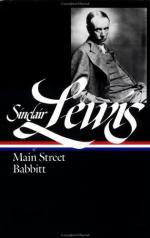The universal sign of winter was the town handyman—Miles Bjornstam, a tall, thick, red-mustached bachelor, opinionated atheist, general-store arguer, cynical Santa Claus. Children loved him, and he sneaked away from work to tell them improbable stories of sea-faring and horse-trading and bears. The children’s parents either laughed at him or hated him. He was the one democrat in town. He called both Lyman Cass the miller and the Finn homesteader from Lost Lake by their first names. He was known as “The Red Swede,” and considered slightly insane.
Bjornstam could do anything with his hands—solder a pan, weld an automobile spring, soothe a frightened filly, tinker a clock, carve a Gloucester schooner which magically went into a bottle. Now, for a week, he was commissioner general of Gopher Prairie. He was the only person besides the repairman at Sam Clark’s who understood plumbing. Everybody begged him to look over the furnace and the water-pipes. He rushed from house to house till after bedtime—ten o’clock. Icicles from burst water-pipes hung along the skirt of his brown dog-skin overcoat; his plush cap, which he never took off in the house, was a pulp of ice and coal-dust; his red hands were cracked to rawness; he chewed the stub of a cigar.
But he was courtly to Carol. He stooped to examine the furnace flues; he straightened, glanced down at her, and hemmed, “Got to fix your furnace, no matter what else I do.”
The poorer houses of Gopher Prairie, where the services of Miles Bjornstam were a luxury—which included the shanty of Miles Bjornstam—were banked to the lower windows with earth and manure. Along the railroad the sections of snow fence, which had been stacked all summer in romantic wooden tents occupied by roving small boys, were set up to prevent drifts from covering the track.
The farmers came into town in home-made sleighs, with bed-quilts and hay piled in the rough boxes.
Fur coats, fur caps, fur mittens, overshoes buckling almost to the knees, gray knitted scarfs ten feet long, thick woolen socks, canvas jackets lined with fluffy yellow wool like the plumage of ducklings, moccasins, red flannel wristlets for the blazing chapped wrists of boys—these protections against winter were busily dug out of moth-ball-sprinkled drawers and tar-bags in closets, and all over town small boys were squealing, “Oh, there’s my mittens!” or “Look at my shoe-packs!” There is so sharp a division between the panting summer and the stinging winter of the Northern plains that they rediscovered with surprise and a feeling of heroism this armor of an Artic explorer.
Winter garments surpassed even personal gossip as the topic at parties. It was good form to ask, “Put on your heavies yet?” There were as many distinctions in wraps as in motor cars. The lesser sort appeared in yellow and black dogskin coats, but Kennicott was lordly in a long raccoon ulster and a new seal cap. When the snow was too deep for his motor he went off on country calls in a shiny, floral, steel-tipped cutter, only his ruddy nose and his cigar emerging from the fur.




